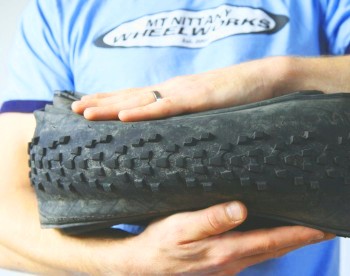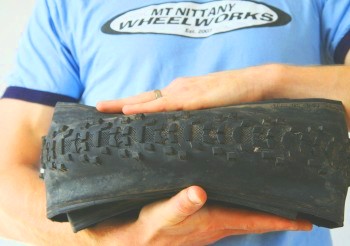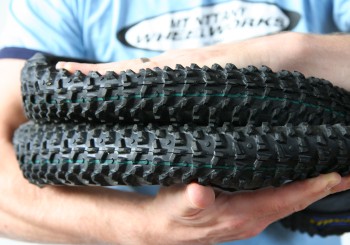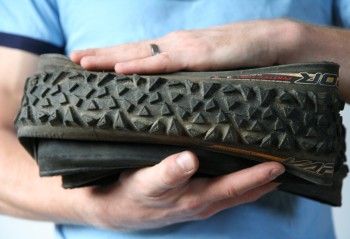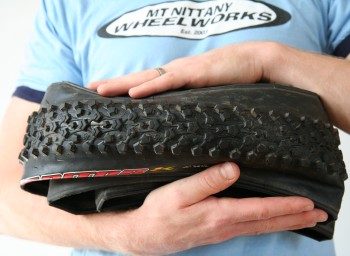[ 63XC.COM | REVIEWS | 29" TYRES ]
Tyred out
Changing from a 26 inch wheel bike to a 29 inch wheel bike forced me to re-evaluate several aspects of my riding equipment and position. It had been simple enough to consider a stem change here, or a millimeter of saddle setback there, but my tyre of choice simply was not available in the 29er size. I had almost exclusively used Continental Vertical ProTection for years, but now I needed to choose again. It seemed I had come full circle. I enjoyed being forced to try things out again, rather than relying on the tried and true.
Initially, I resorted to a tyre I had used previously on smaller wheels. The IRC Mythos II uses a simple block tread with an overall wedge design front and paddle design rear. By and large they run narrow for stated size, which for 29ers is 2.1" only. My first reaction could be described as 'phew'. At the very least it worked, was comfortable and reasonably durable. Availability was an issue in the UK, although the situation has improved somewhat. Fortunately, the internet allows scope for greater choice.
I rode the tyre in varied conditions for several months, discovering a few quirks in the process. The Mythos has a tendency to break away in cornering. On wet rocks and roots, the performance is acceptable rather than confident. This started the vultures circling in my head. My bike is set up precisely to allow me to lean into corners, and 'wet rocks and roots' neatly summarises the local topography and weather. I regretted the sense of security a 2.3" tyre had given me in my 26incher days, and I began to cast my eyes about. I looked at manufacturers whose tyres I had never considered before: Schwalbe, Maxxis, Bontrager. I also looked for info regarding construction, durability and cross section. This made interesting reading. I convinced myself that I wanted to try a big fat meat. There was really only one choice: the WTB Exi Wolf. This is a tread with multiple bladed small knobs, which wrap a good way around a rather square profile with a big carcass and a thick sidewall. I went with the steel bead version for added security at lower pressures.
Needless to say, traction in almost all circumstances was improved. But, oh my, the weight of these things! It was depressing to think of the albatross hanging from my wheels every time I tried to spin up to speed. Still, I figured for occasional use, in specific terrain (say rocky Highlands or Downieville) they have their place in my tyre collection. After this I became hooked on the idea that rubber compound was just as important as girth and that I really needed to pay attention to weight. My next purchase was a pair of super-narrow Continental Vapors. The low weight was a boon, especially after the Exis, and the unusual triangular knobbed pattern combined minimal rolling resistance with only gradual loss of traction as with increasing lean angle. Plus, I fitted them just in time for winter and the mud performance was exquisite. They cut through the muck and gripped easily. Unfortunately, as a 24 hr race showed, the necessary high pressures (to avoid pinch flats) and the relative lowering of gear (I ride a singlespeed) were less worthy features.
So, I tucked my tail between my legs and re-fitted the Mythos. I then tried all the aforementioned in various front-rear combinations, even cross tyres. Satisfaction evaded me. Then I had the good fortune to visit Pennsylvania for the Wilderness 101 this July. I spent some time annoying the local bike shop in State College. No issue, they said, Maxxis Ignitors. Full stop.
I had a look. I have to say that, if these tyres are not made in a mould born from the Vertical Pro, then I am sorely mistaken. The cross section, size, pattern of tread blocks and even the twiddly little patterns inbetween to aid grip are so similar it is spooky. The stud-style, multi-faceted blocks in a softish rubber grip well in all manner of circumstances. I have no doubt in clay-like mud they will clog just as quickly as Verticals, but they roll fast and quietly, grip well even when well worn and stay put at moderate PSI. I believe I have found 'my tyre': sure-footed in cornering, grippy in the climbs, and all without robbing my heart or legs of hope while covering the miles. It has taken 18 months to find a tyre whose performance approximates that of my 26inchers. I've read a lot of opinions on the subject, including inanities. The most important thing I've learned is that everyone needs to find a tyre that suits them most of the time. You can always change tyres for specific conditions, but you still need a reference point against which to measure your other choices. In choosing this 'base' tyre, you need to figure out the factor or factors that matter most to you. Is is weight? Sidewall protection? Rolling resistance? Mud clearance? Traction on stone? Experimentation can be expensive, but it's better to try out alternatives than to stick with a tyre that disappoints you. (Maybe you could begin a 'tyre bank' with your friends to ease the financial burden.) Consider keeping a tyre diary to record the factors which affect your ride. Above all, don't believe the hype. Your own experience matters a lot more than what people tell you. Remember: what goes around, comes around.
[ TOP ] |
Writer
dRjOn: sometime outcaster, racer and bike nomad
Date
v1.0 written August 2006
Related
dRj0n runs an excellent blog.
Mailing list
Join the 63xc.com list.
